flat tire CADILLAC ESCALADE ESV 2008 Owners Manual
[x] Cancel search | Manufacturer: CADILLAC, Model Year: 2008, Model line: ESCALADE ESV, Model: CADILLAC ESCALADE ESV 2008Pages: 500, PDF Size: 6.65 MB
Page 334 of 500
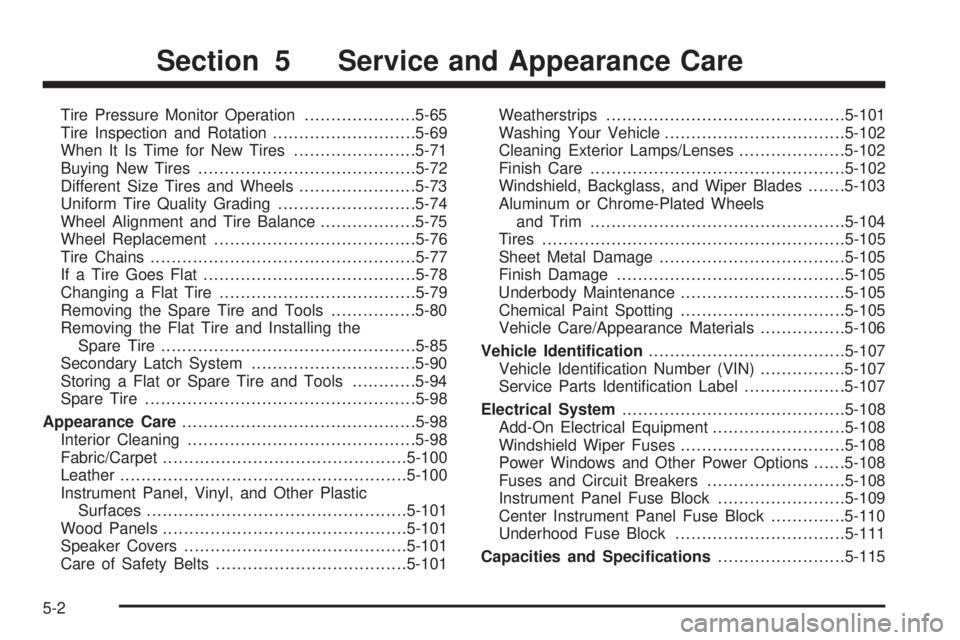
Tire Pressure Monitor Operation .................... .5-65
Tire Inspection and Rotation .......................... .5-69
When It Is Time for New Tires ...................... .5-71
Buying New Tires ........................................ .5-72
Different Size Tires and Wheels ..................... .5-73
Uniform Tire Quality Grading ......................... .5-74
Wheel Alignment and Tire Balance ................. .5-75
Wheel Replacement ..................................... .5-76
Tire Chains ................................................. .5-77
If a Tire Goes Flat ....................................... .5-78
Changing a Flat Tire .................................... .5-79
Removing the Spare Tire and Tools ............... .5-80
Removing the Flat Tire and Installing the
Spare Tire ............................................... .5-85
Secondary Latch System .............................. .5-90
Storing a Flat or Spare Tire and Tools ........... .5-94
Spare Tire .................................................. .5-98
Appearance Care ........................................... .5-98
Interior Cleaning .......................................... .5-98
Fabric/Carpet ............................................. .5-100
Leather ..................................................... .5-100
Instrument Panel, Vinyl, and Other Plastic
Surfaces ................................................ .5-101
Wood Panels ............................................. .5-101
Speaker Covers ......................................... .5-101
Care of Safety Belts ................................... .5-101 Weatherstrips ............................................ .5-101
Washing Your Vehicle ................................. .5-102
Cleaning Exterior Lamps/Lenses ................... .5-102
Finish Care ............................................... .5-102
Windshield, Backglass, and Wiper Blades ...... .5-103
Aluminum or Chrome-Plated Wheels
and Trim ............................................... .5-104
Tires ........................................................ .5-105
Sheet Metal Damage .................................. .5-105
Finish Damage .......................................... .5-105
Underbody
Maintenance .............................. .5-105
Chemical Paint Spotting .............................. .5-105
Vehicle Care/Appearance Materials ............... .5-106
Vehicle Identi�cation .................................... .5-107
Vehicle Identi�cation Number (VIN) ............... .5-107
Service Parts Identi�cation Label .................. .5-107
Electrical System ......................................... .5-108
Add-On Electrical Equipment ........................ .5-108
Windshield Wiper Fuses .............................. .5-108
Power Windows and Other Power Options ..... .5-108
Fuses and Circuit Breakers ......................... .5-108
Instrument Panel Fuse Block ....................... .5-109
Center Instrument Panel Fuse Block ............. .5-110
Underhood Fuse Block ............................... .5-111
Capacities and Speci�cations ....................... .5-115Section 5 Service and Appearance Care
5-2
Page 402 of 500
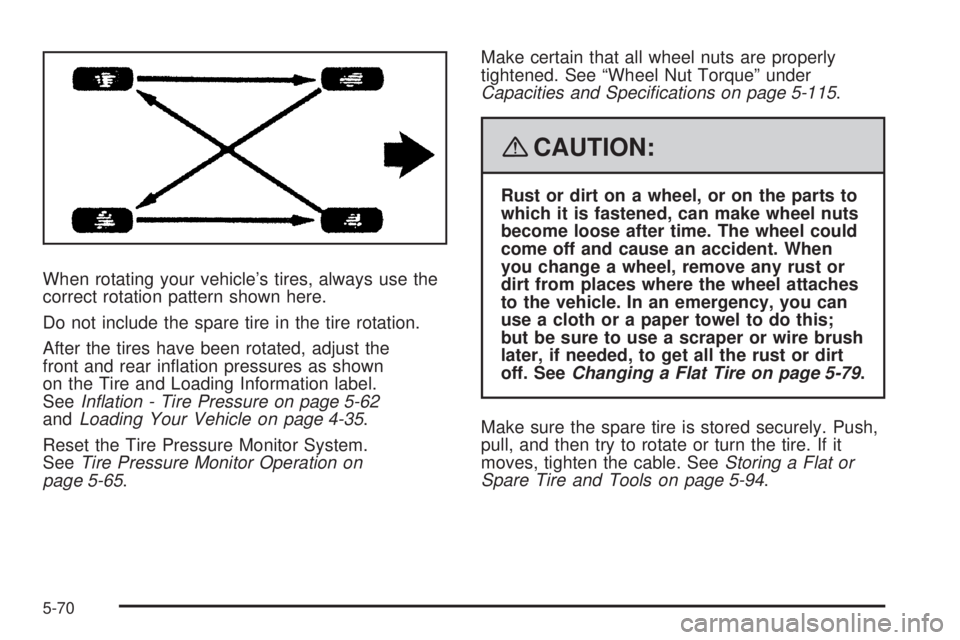
When rotating your vehicle’s tires, always use the
correct rotation pattern shown here.
Do not include the spare tire in the tire rotation.
After the tires have been rotated, adjust the
front and rear in�ation pressures as shown
on the Tire and Loading Information label.
See Inflation - Tire Pressure on page 5-62
and Loading Your Vehicle on page 4-35 .
Reset the Tire Pressure Monitor System.
See Tire Pressure Monitor Operation on
page 5-65 . Make certain that all wheel nuts are properly
tightened. See “Wheel Nut Torque” under
Capacities and Specifications on page 5-115 .
{ CAUTION: Rust or dirt on a wheel, or on the parts to
which it is fastened, can make wheel nuts
become loose after time. The wheel could
come off and cause an accident. When
you change a wheel, remove any rust or
dirt from places where the wheel attaches
to the vehicle. In an emergency, you can
use a cloth or a paper towel to do this;
but be sure to use a scraper or wire brush
later, if needed, to get all the rust or dirt
off. See Changing a Flat Tire on page 5-79 .
Make sure the spare tire is stored securely. Push,
pull, and then try to rotate or turn the tire. If it
moves, tighten the cable. See Storing a Flat or
Spare Tire and Tools on page 5-94 .
5-70
Page 408 of 500
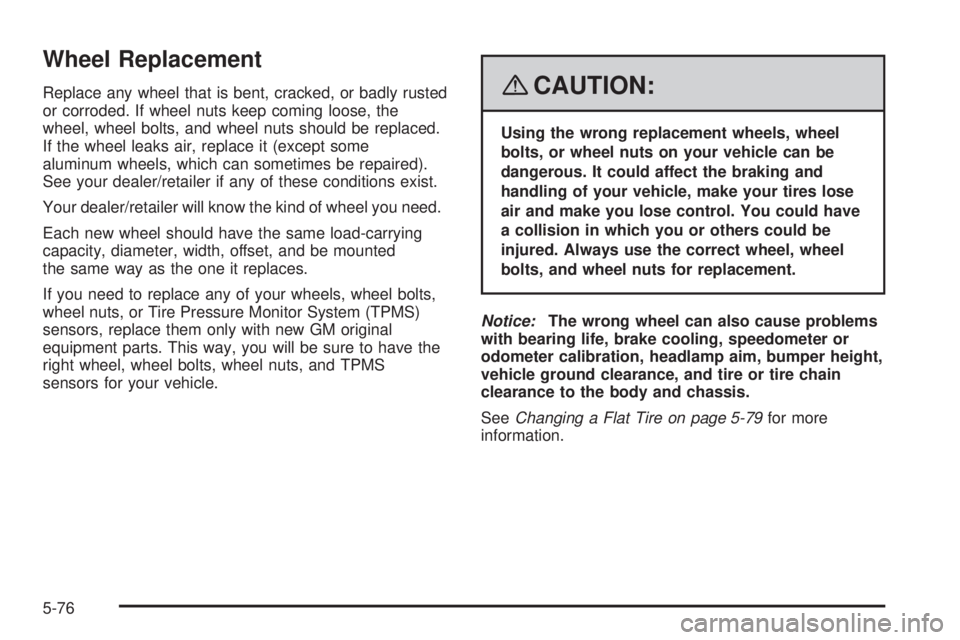
Wheel Replacement Replace any wheel that is bent, cracked, or badly rusted
or corroded. If wheel nuts keep coming loose, the
wheel, wheel bolts, and wheel nuts should be replaced.
If the wheel leaks air, replace it (except some
aluminum wheels, which can sometimes be repaired).
See your dealer/retailer if any of these conditions exist.
Your dealer/retailer will know the kind of wheel you need.
Each new wheel should have the same load-carrying
capacity, diameter, width, offset, and be mounted
the same way as the one it replaces.
If you need to replace any of your wheels, wheel bolts,
wheel nuts, or Tire Pressure Monitor System (TPMS)
sensors, replace them only with new GM original
equipment parts. This way, you will be sure to have the
right wheel, wheel bolts, wheel nuts, and TPMS
sensors for your vehicle. { CAUTION: Using the wrong replacement wheels, wheel
bolts, or wheel nuts on your vehicle can be
dangerous. It could affect the braking and
handling of your vehicle, make your tires lose
air and make you lose control. You could have
a collision in which you or others could be
injured. Always use the correct wheel, wheel
bolts, and wheel nuts for replacement.
Notice: The wrong wheel can also cause problems
with bearing life, brake cooling, speedometer or
odometer calibration, headlamp aim, bumper height,
vehicle ground clearance, and tire or tire chain
clearance to the body and chassis.
See Changing a Flat Tire on page 5-79 for more
information.
5-76
Page 410 of 500

If a Tire Goes Flat It is unusual for a tire to blowout while you are driving,
especially if you maintain your vehicle’s tires properly.
If air goes out of a tire, it is much more likely to leak out
slowly. But if you should ever have a blowout, here
are a few tips about what to expect and what to do:
If a front tire fails, the �at tire creates a drag that pulls
the vehicle toward that side. Take your foot off the
accelerator pedal and grip the steering wheel �rmly.
Steer to maintain lane position, and then gently brake to
a stop well out of the traffic lane.
A rear blowout, particularly on a curve, acts much like a
skid and may require the same correction you would
use in a skid. In any rear blowout remove your foot from
the accelerator pedal. Get the vehicle under control
by steering the way you want the vehicle to go. It may
be very bumpy and noisy, but you can still steer.
Gently brake to a stop, well off the road if possible. { CAUTION: Lifting a vehicle and getting under it to do
maintenance or repairs is dangerous without
the appropriate safety equipment and training.
The jack provided with your vehicle is
designed only for changing a �at tire. If it is
used for anything else, you or others could be
badly injured or killed if the vehicle slips off
the jack. Use the jack provided with your
vehicle only for changing a �at tire.
If a tire goes �at, the next part shows how to use the
jacking equipment to change a �at tire safely.
5-78
Page 411 of 500
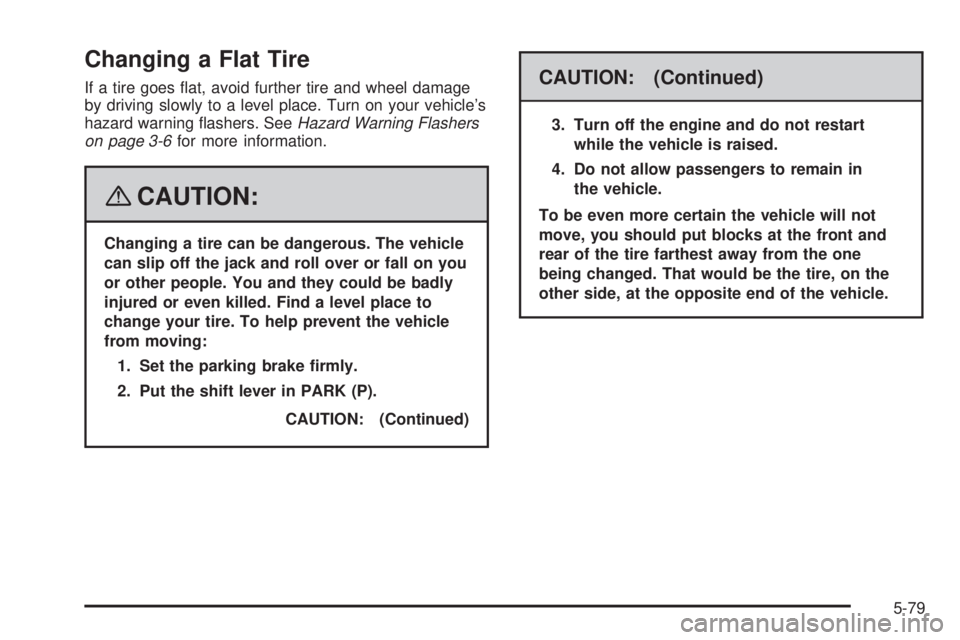
Changing a Flat Tire If a tire goes �at, avoid further tire and wheel damage
by driving slowly to a level place. Turn on your vehicle’s
hazard warning �ashers. See Hazard Warning Flashers
on page 3-6 for more information.
{ CAUTION: Changing a tire can be dangerous. The vehicle
can slip off the jack and roll over or fall on you
or other people. You and they could be badly
injured or even killed. Find a level place to
change your tire. To help prevent the vehicle
from moving:
1. Set the parking brake �rmly.
2. Put the shift lever in PARK (P).
CAUTION: (Continued) CAUTION: (Continued) 3. Turn off the engine and do not restart
while the vehicle is raised.
4. Do not allow passengers to remain in
the vehicle.
To be even more certain the vehicle will not
move, you should put blocks at the front and
rear of the tire farthest away from the one
being changed. That would be the tire, on the
other side, at the opposite end of the vehicle.
5-79
Page 417 of 500

Removing the Flat Tire and
Installing the Spare Tire 1. Do a safety check before proceeding. See Changing
a Flat Tire on page 5-79 for more information.
2. To remove the center cap, place the chiseled end
of the wheel wrench in the slot on the wheel and
gently pry the cap out.
3. Use the wheel wrench to loosen all the wheel nuts.
Turn the wheel wrench counterclockwise to loosen
the wheel nuts. Do not remove the wheel nuts yet. A. Front Position
B. Rear Position
{ CAUTION: Getting under a vehicle when it is jacked up is
dangerous. If the vehicle slips off the jack, you
could be badly injured or killed. Never get under
a vehicle when it is supported only by a jack. Jacking Locations (Overall View)
5-85
Page 418 of 500
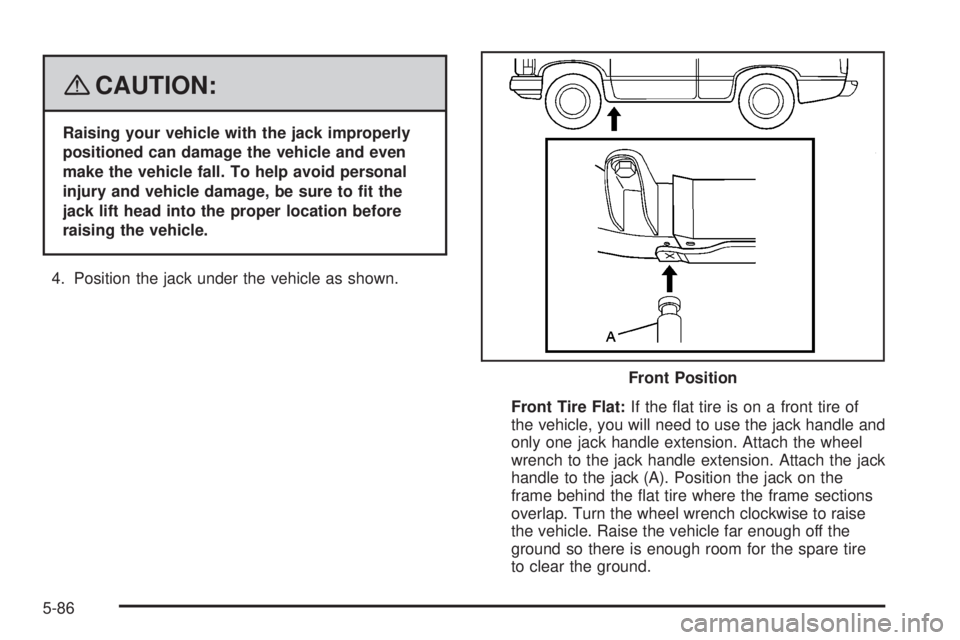
{ CAUTION: Raising your vehicle with the jack improperly
positioned can damage the vehicle and even
make the vehicle fall. To help avoid personal
injury and vehicle damage, be sure to �t the
jack lift head into the proper location before
raising the vehicle.
4. Position the jack under the vehicle as shown.
Front Tire Flat: If the �at tire is on a front tire of
the vehicle, you will need to use the jack handle and
only one jack handle extension. Attach the wheel
wrench to the jack handle extension. Attach the jack
handle to the jack (A). Position the jack on the
frame behind the �at tire where the frame sections
overlap. Turn the wheel wrench clockwise to raise
the vehicle. Raise the vehicle far enough off the
ground so there is enough room for the spare tire
to clear the ground. Front Position
5-86
Page 419 of 500

Rear Tire Flat: If the �at tire is on a rear tire of the
vehicle, you will need to use the jack handle (B)
and both jack handle extensions (C). Attach
the wheel wrench (D) to the jack handle
extensions (C). Attach the jack handle (B) to the
jack (A). Use the jacking pad provided on the rear
axle. Turn the wheel wrench (D) clockwise to
raise the vehicle. Raise the vehicle far enough off
the ground so there is enough room for the
spare tire to clear the ground. 5. Remove all of the
wheel nuts.
6. Take off the �at tire.
Rear Position
5-87
Page 420 of 500
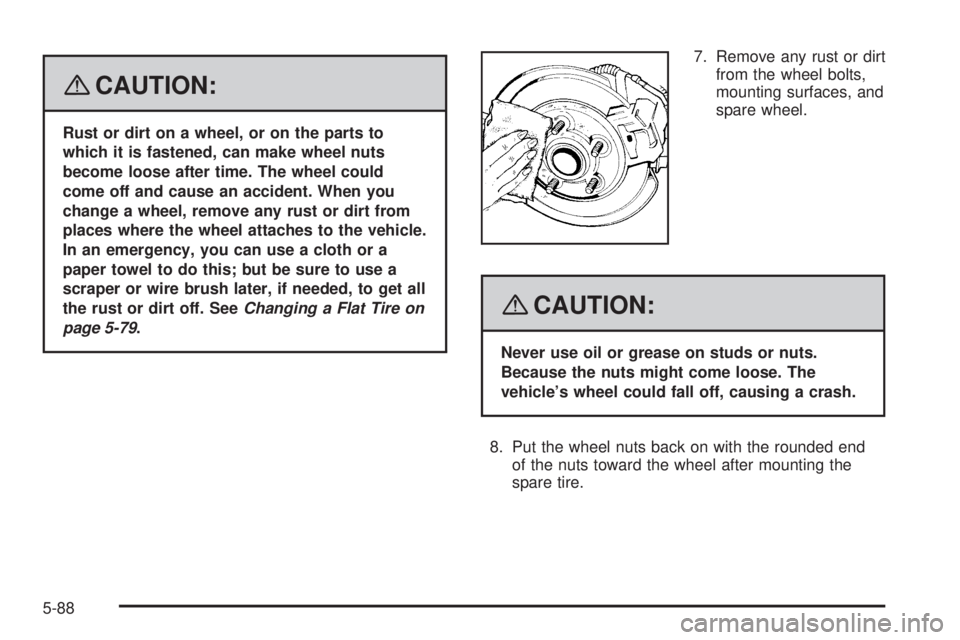
{ CAUTION: Rust or dirt on a wheel, or on the parts to
which it is fastened, can make wheel nuts
become loose after time. The wheel could
come off and cause an accident. When you
change a wheel, remove any rust or dirt from
places where the wheel attaches to the vehicle.
In an emergency, you can use a cloth or a
paper towel to do this; but be sure to use a
scraper or wire brush later, if needed, to get all
the rust or dirt off. See Changing a Flat Tire on
page 5-79 . 7. Remove any rust or dirt
from the wheel bolts,
mounting surfaces, and
spare wheel.
{ CAUTION: Never use oil or grease on studs or nuts.
Because the nuts might come loose. The
vehicle’s wheel could fall off, causing a crash.
8. Put the wheel nuts back on with the rounded end
of the nuts toward the wheel after mounting the
spare tire.
5-88
Page 422 of 500

Secondary Latch System Your vehicle has an underbody-mounted tire hoist
assembly equipped with a secondary latch system. It is
designed to stop the spare tire from suddenly falling
off your vehicle. For the secondary latch to work,
the spare must be installed with the valve stem pointing
down. See Storing a Flat or Spare Tire and Tools on
page 5-94 .
{ CAUTION: Before beginning this procedure read all the
instructions. Failure to read and follow the
instructions could damage the hoist assembly
and you and others could get hurt. Read and
follow the instructions listed next. To release the spare tire from the secondary latch:
1. Check under the
vehicle to see if the
cable end is visible.
If the cable is not
visible proceed
to Step 6.
2. If it is visible, �rst try to tighten the cable by turning
the wheel wrench clockwise until you hear two clicks
or feel it skip twice. You cannot overtighten the cable.
3. Loosen the cable by turning the wrench
counterclockwise three or four turns.
4. Repeat this procedure at least two times. If the
spare tire lowers to the ground, continue with
Step 5 of Removing the Spare Tire and Tools on
page 5-80 .
5-90